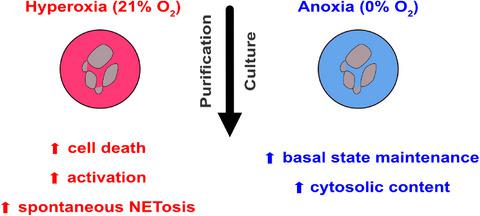当前位置:
X-MOL 学术
›
Immunol. Cell Biol.
›
论文详情
Our official English website, www.x-mol.net, welcomes your feedback! (Note: you will need to create a separate account there.)
Reducing neutrophil exposure to oxygen allows their basal state maintenance
Immunology and Cell Biology ( IF 4 ) Pub Date : 2021-04-03 , DOI: 10.1111/imcb.12458 Louise Injarabian 1, 2, 3 , Jurate Skerniskyte 2 , Quentin Giai Gianetto 4, 5 , Véronique Witko‐Sarsat 6 , Benoit S Marteyn 2, 7
Immunology and Cell Biology ( IF 4 ) Pub Date : 2021-04-03 , DOI: 10.1111/imcb.12458 Louise Injarabian 1, 2, 3 , Jurate Skerniskyte 2 , Quentin Giai Gianetto 4, 5 , Véronique Witko‐Sarsat 6 , Benoit S Marteyn 2, 7
Affiliation

|
Neutrophils are the most abundant circulating white blood cells and are the central players of the innate immune response. During their lifecycle, neutrophils mainly evolve under low oxygen conditions (0.1–4% O2), to which they are well adapted. Neutrophils are atypical cells since they are highly glycolytic and susceptible to oxygen exposure, which induces their activation and death through mechanisms that remain currently elusive. Nevertheless, nearly all studies conducted on neutrophils are carried out under atmospheric oxygen (21%), corresponding to hyperoxia. Here, we investigated the impact of hyperoxia during neutrophil purification and culture on neutrophil viability, activation and cytosolic protein content. We demonstrate that neutrophil hyper-activation (CD62L shedding) is induced during culture under hyperoxic conditions (24 h), compared with neutrophils cultured under anoxic conditions. Spontaneous neutrophil extracellular trap (NET) formation is observed when neutrophils face hyperoxia during purification or culture. In addition, we show that maintaining neutrophils in autologous plasma is the preferred strategy to maintain their basal state. Our results show that manipulating neutrophils under hyperoxic conditions leads to the loss of 57 cytosolic proteins during purification, while it does not lead to an immediate impact on neutrophil activation (CD11bhigh, CD54high, CD62Lneg) or viability (DAPI+). We identified two clusters of proteins belonging to cholesterol metabolism and to the complement and coagulation cascade pathways, which are highly susceptible to neutrophil oxygen exposure during neutrophil purification. In conclusion, protecting neutrophil from oxygen during their purification and culture is recommended to avoid activation and to prevent the alteration of cytosolic protein composition.
中文翻译:

减少中性粒细胞与氧气的接触可以维持它们的基础状态
中性粒细胞是最丰富的循环白细胞,是先天免疫反应的核心参与者。在其生命周期中,中性粒细胞主要在低氧条件下(0.1–4% O 2),他们很好地适应了。中性粒细胞是非典型细胞,因为它们高度糖酵解并且易受氧暴露,这通过目前仍然难以捉摸的机制诱导它们的活化和死亡。尽管如此,几乎所有对中性粒细胞进行的研究都是在大气氧气 (21%) 下进行的,对应于高氧。在这里,我们研究了中性粒细胞纯化和培养过程中高氧对中性粒细胞活力、活化和胞质蛋白含量的影响。我们证明,与在缺氧条件下培养的中性粒细胞相比,在高氧条件下(24 小时)培养过程中会诱导中性粒细胞过度活化(CD62L 脱落)。当中性粒细胞在纯化或培养过程中面临高氧时,会观察到自发的中性粒细胞胞外陷阱 (NET) 形成。此外,我们表明,在自体血浆中维持中性粒细胞是维持其基础状态的首选策略。我们的结果表明,在高氧条件下操纵中性粒细胞会导致纯化过程中 57 种胞质蛋白丢失,但不会立即影响中性粒细胞活化(CD11b高、CD54高、CD62L阴性)或生存力(DAPI +)。我们确定了属于胆固醇代谢和补体和凝血级联通路的两个蛋白质簇,它们在中性粒细胞纯化过程中对中性粒细胞氧暴露高度敏感。总之,建议在中性粒细胞的纯化和培养过程中保护它们免受氧气的影响,以避免激活并防止细胞溶质蛋白组成的改变。
更新日期:2021-04-03
中文翻译:

减少中性粒细胞与氧气的接触可以维持它们的基础状态
中性粒细胞是最丰富的循环白细胞,是先天免疫反应的核心参与者。在其生命周期中,中性粒细胞主要在低氧条件下(0.1–4% O 2),他们很好地适应了。中性粒细胞是非典型细胞,因为它们高度糖酵解并且易受氧暴露,这通过目前仍然难以捉摸的机制诱导它们的活化和死亡。尽管如此,几乎所有对中性粒细胞进行的研究都是在大气氧气 (21%) 下进行的,对应于高氧。在这里,我们研究了中性粒细胞纯化和培养过程中高氧对中性粒细胞活力、活化和胞质蛋白含量的影响。我们证明,与在缺氧条件下培养的中性粒细胞相比,在高氧条件下(24 小时)培养过程中会诱导中性粒细胞过度活化(CD62L 脱落)。当中性粒细胞在纯化或培养过程中面临高氧时,会观察到自发的中性粒细胞胞外陷阱 (NET) 形成。此外,我们表明,在自体血浆中维持中性粒细胞是维持其基础状态的首选策略。我们的结果表明,在高氧条件下操纵中性粒细胞会导致纯化过程中 57 种胞质蛋白丢失,但不会立即影响中性粒细胞活化(CD11b高、CD54高、CD62L阴性)或生存力(DAPI +)。我们确定了属于胆固醇代谢和补体和凝血级联通路的两个蛋白质簇,它们在中性粒细胞纯化过程中对中性粒细胞氧暴露高度敏感。总之,建议在中性粒细胞的纯化和培养过程中保护它们免受氧气的影响,以避免激活并防止细胞溶质蛋白组成的改变。



























 京公网安备 11010802027423号
京公网安备 11010802027423号